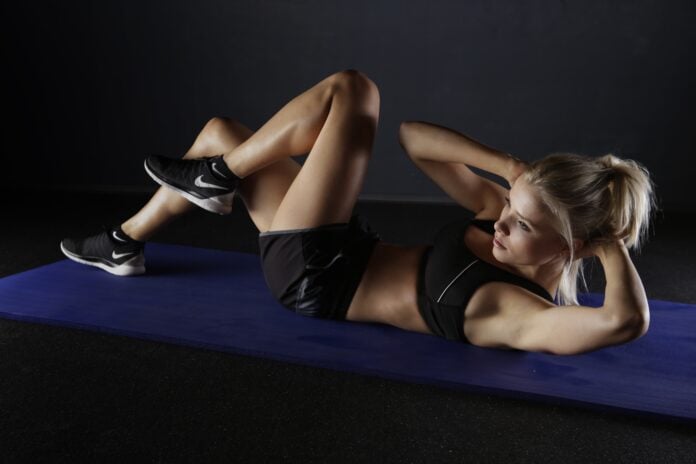Reverse Crunch is a great exercise for your Abdominals. However, there are many variations that fit different levels of sportsmen’s experience. We’ve chosen the safest, yet most effective variations for this article. Here’s a great detailed guide for anyone who wants to do the reverse crunch in the correct way.
Intermediate Level
The reverse crunch, which is an intermediate version of the abdominal crunch exercise, can be used as a variation. While your upper body is on the mat, contract your abs and draw your legs towards your chest. This exercise works the entire length of the six-pack muscle, the rectus abdominal muscle. It also strengthens the lower abs. This bodyweight exercise can be added to any core or abdominal workout, or used as part of a complete body workout.
If you experience neck discomfort from the traditional crunch and situp, the reverse crunch might be a better choice. You will be able to activate all your abdominal muscles, as well as the external obliques at the sides. This exercise is great for building a strong stomach and functional abs.
Strong core strength is essential for improving your performance in sports and for maintaining stability, balance, and good posture throughout daily life. You will be able to perform more vigorous sports and other activities around the house, such as gardening, which requires bending, twisting, and reaching. You should include different ab exercises in your workouts to challenge your core muscles in a variety of ways.
Step-by-Step Instructions
Place your arms in front of you on the mat. You can have them closer to you or extend them comfortably for balance.
1. Keep your knees bent at the knee, and your abs braced to raise your legs until your knees meet your hips. This is your starting position. Hold the abs straight and maintain a neutral spine position.
2. Inhale and contract your abs as you curl your hips towards your chest. Your hips will be pointing toward your chest as you exhale. Throughout this upward phase, your knees should stay at the same angle. Keep your head straight, and keep your neck and shoulders relaxed on the mat. When your back is not touching the mat, hold.
3. Slowly exhale, bringing your hips back to the mat. Your knees are still bent 90 degrees.
4. Start with 10 repetitions of three sets, and then increase the number as you gain strength.
Common Mistakes
These mistakes can be avoided to get the best out of your exercise and prevent injury.
- Momentum. It’s tempting to speed up the reverse crunch and allow momentum to pull you up, rather than contract your abs. You should avoid this by slowing down and being careful. You need to strengthen your abs with additional ab exercises if you find it difficult to pull your legs towards your chest while not using momentum.
- Rolling Too Far. In the upward phase, only your hips and tailbone should be lifted off the mat. If you lose contact with your back, stop. You are more likely to do the reverse crunch slowly than if you use momentum and move faster.
- Unrolling too far. Be careful not to roll too far on the downward return so that your knees don’t touch the hips. You should be able to stop if you’re moving slowly. However, if your body isn’t strong enough to slow down, you may find that you let your body sink instead. This indicates that your abs need to be strengthened before you can do the reverse crunch in good form.
Modifications and Variations
There are many different ways to perform crunches. As they gain strength, beginners can switch to a format that is easier for them. You can increase the difficulty as you move on.
Do You Need a Modification?
You may find that you are unable to control the movement or have the strength to roll up with momentum. You should only go as far as possible with control in the upward phase. This may seem like a small motion, but it won’t raise your tailbone off the ground.
Toe-tapping can help you build strength. Start by lowering one leg with a pointed toe from the starting position until it touches the ground. Then, return the leg to its original position. Next, repeat the process with the second leg. Throughout this exercise, keep your lower back, hips, and tailbone on a mat. Try doing 15 to 20 taps on each side.
Are You Up for a Challenge?
The full crunch, or combined crunch, integrates shoulder and hip movement into one exercise. You can start with your legs bent at 90 degrees, or your knees bent at the ground. This advanced exercise targets the rectus abdominis as well as the external obliques (muscles at the sides and abdomen). If you can complete three sets of 15 combined crunches, you will know that your abs and hip flexors are in great shape.
Safety and Precautions
Talk to your doctor if you have neck or back injuries. This exercise will cause stress, burning sensations in the abdominal muscles, and some discomfort. However, you won’t feel any pain. You should stop if you feel any discomfort in your stomach, back or neck. Pregnant women should avoid this exercise.
You Should Try It Out
This move, along with others, can be incorporated into any of these popular workouts.


